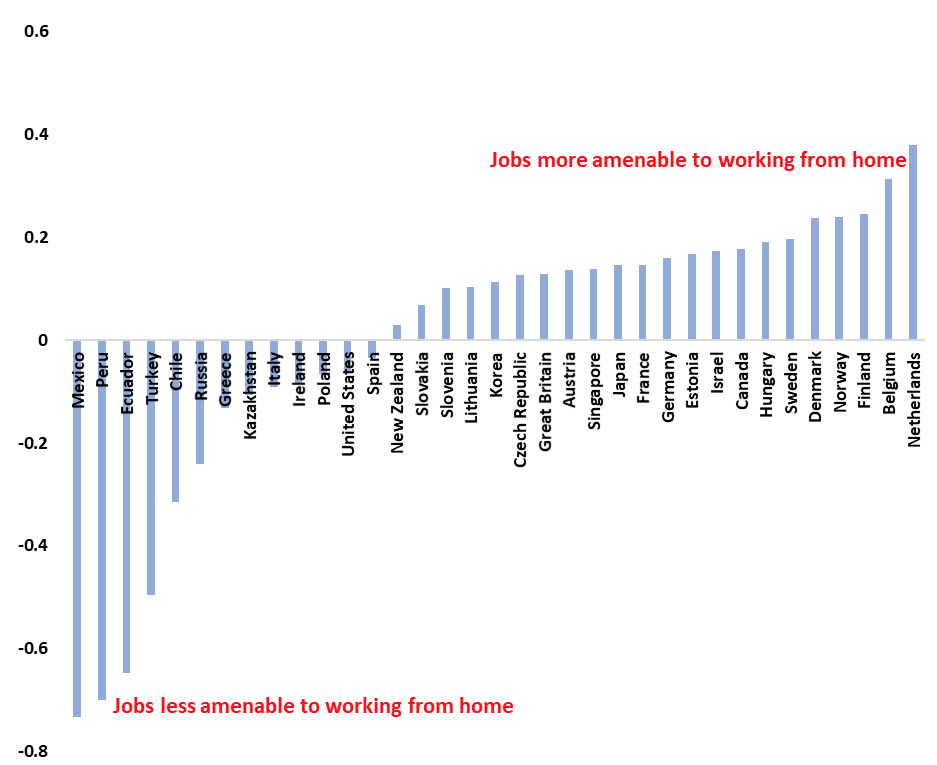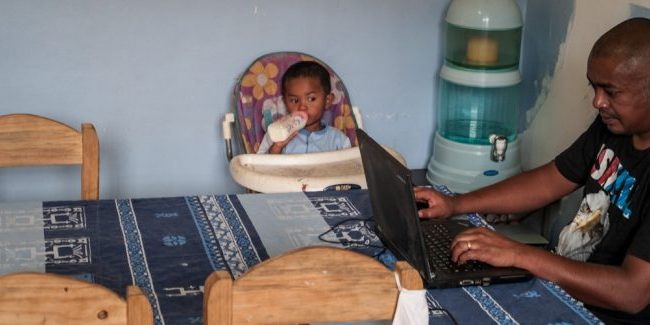Governments of developing countries should consider WFH as a crucial part of the new digital economy when they invest in broadband infrastructure. Photo credit: World Bank
Authors: Maho Hatayama, Mariana Viollaz, and Hernan Winkler
The coronavirus (COVID-19) crisis and implementation of social distancing policies around the world has raised the question of how many jobs can be done at home. But answering it has proved an elusive quest, since researchers and policymakers cannot see in real-time who is able to work from home during the pandemic.
In our new paper, we attempt to get around these issues by constructing a new global work-from-home (WFH) measure.
Estimating jobs’ amenability to working from home
We created our global WFH measure using skill surveys from dozens of countries. The measure takes into account four components:
- A manual work component, to capture tasks that are more likely to be location-specific and cannot be done at home.
- A face-to-face (F2F) intensity component, which captures tasks such as supervision or contact with the public.
- An information and communication technology (ICT) component that reflects the fact that some interactions can be handled remotely.
- A component considering the internet connection at home. Workers in developing countries who may use ICT at the workplace do not necessarily have access to the same resources at home.
By combining the four components, we came up with our WFH measure. Figure 1 (below) shows this measure for 35 countries that participated in a skill survey by the Organisation for Economic Cooperation and Development (OECD). Among these countries, the Netherlands’ economy is most suited for WFH, while Mexico’s is the least. Share on X The United States is less amenable to WFH than most European countries, because its jobs are more intensive in physical tasks that must be carried out at a specific location. In general, we find a strong association between the amenability of jobs to WFH, GDP per capita, and internet penetration. (For a more detailed analysis of the 53 total countries we looked at, read the paper.)
 Figure 1: The size of the bar is proportional to the amenability of jobs to WFH. Positive values mean that jobs’ amenability to WFH is higher than in the average job of this group of countries.
Figure 1: The size of the bar is proportional to the amenability of jobs to WFH. Positive values mean that jobs’ amenability to WFH is higher than in the average job of this group of countries.
Studying the components individually and in relation to each other also yields interesting results. One finding is that the manual intensity of jobs declines with GDP per capita, while F2F interaction increases. F2F intensive occupations, such as lawyers or CEOs, also tend to use more ICT, indicating that several of the tasks embedded in such occupations are more prone to be performed remotely.
We also document the importance of distinguishing between ICT use at work and the availability of an internet connection at home. While both variables are highly correlated — i.e. countries where people use more ICT at work also have higher internet connectivity at home — there are some differences, particularly among less developed countries. For instance, the Philippines ranks relatively high in terms of ICT use at work, but it has relatively low levels of internet connectivity at home. Share on X
Our findings also reveal large disparities within countries and among social groups. Jobs more amenable to WFH are more prevalent among workers with high levels of education, in salaried employment, and among younger workers. Women have a higher WFH measure than men. However, even when women’s jobs are more amenable to WFH, the unequal distribution of domestic work and childcare responsibilities within households may impact negatively on their chances to do it. Finally, sectors such as ICT, professional services, the public sector, and finance are more amenable to WFH.
Implications for policy
Our results also highlight the importance of policy efforts to reach informal workers, as they are less likely to be able to work from home and to be covered by programs implemented through the social security or tax administration infrastructures. To a large extent, divides in WFH amenability between and within countries are driven by unequal access to ICT. Governments of developing countries should consider WFH as a crucial part of the new digital economy when they invest in broadband infrastructure. Share on X
This blog was also published by the WBG Jobs
This is the twelfth blog on ways to protect workers and jobs in the COVID-19 (Coronavirus) crisis. Stay tuned for more blogs in the series.




